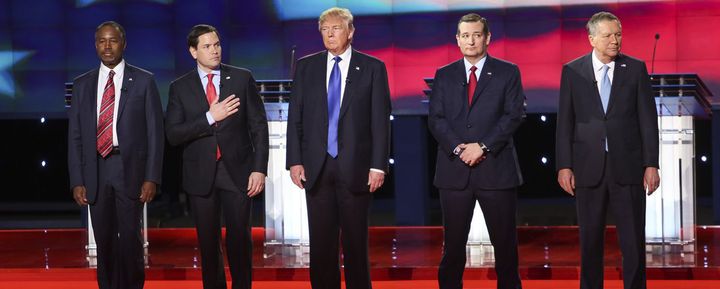
Then-Republican presidential candidate Donald Trump prepares for a primary debate in February, 2015.
It was back in February 2016 when I shared an early lunch with a colleague at our unusually empty cafeteria. CNN runs nonstop on the monitors hanging there, and when few people are around the TV can’t help but catch your attention. In those days—just like these days—CNN was Donald Trump TV, covering every utterance coming from the then-long shot Republican presidential candidate.
On this day, selected highlights from the previous night’s Republican debate were revisiting Trump’s demonstrably false claims that he was opposed to the Iraq War in 2003. This was juxtaposed with polling data that suggested Trump had won the debate. We mused over how easy it must be to run a campaign where you can say anything, truth be damned.
"It's a hell of a strategy," I commented.
"I know,” my colleague replied. "Imagine if we could get away with that." The implication being that communicating on behalf of brands while demonstrating zero regard for the truth, while fun and perhaps rewarding in the short term, is clearly an unsustainable strategy and also, well, wrong.
Right?
Nearly half of American voters would disagree. Donald Trump's communication strategy, dealing in what could charitably be described as half-truths, rode a wave of populist rhetoric to a win in traditionally Democratic strongholds of Michigan and Pennsylvania, and Wisconsin while flipping swing states like Florida and Ohio in his favor. Whatever you say about the communications strategy—the Twitter tirades, targeting private citizens and journalists, calls to violence, the persistent unpopularity—you cannot say it didn’t work. And today, phrases like “post-truth” and “alternative facts” have entered the lexicon.
Empirical Facts Ain’t What They Used to Be
Now, cards on the table here: I'm not a fan of our new President. My own oft-bombastic Twitter feed will tell you as much. I work with colleagues and clients who feel the same way, and many others who feel differently. At 37 I'm old enough to remember a time when a difference in political affiliation was not a toxin for discourse.
But reasonable people can agree on empirical fact, and even many of Trump's more housebroken surrogates have admitted that much of what he says should not be taken as literal truth. (Figurative truth, I suppose?)
So rather than run down a list of immutable facts and Trump's claims counter to them, maybe time is better spent focusing on what it means when an industry based on communicating sees trend-lines among the populace that suggest dishonesty is no longer a deal breaker. After all, the world of PR, marketing and communications loves trend pieces, and what trend would be more game-changing than the wholesale abandonment of truth?
Imagine being on the Chipotle crisis team last year and having the gumption during a strategy session to suggest that, not only should the brand deny outright the proven claims of an e coli outbreak, but it should also deflect criticism by accusing Wingstop and Panera of spreading Zika. Bonkers, I know. You’d be laughed out of the room, and if you weren’t fired you’d at least deserve to be.
Or, how’s this for inspired message management and marketing in the Trump age:
- Samsung: "Not only aren’t our phones exploding, but many people are telling us that iPhones give you halitosis.”
- The Oscars: “No one can prove Leonardo DiCaprio and Brie Larson aren’t people of color.”
- McDonalds: “Our food is healthy. We’re making dinner great again.”
What if strategies like this are no longer off the table? Much has been said and written about the “post-truth” era, an epoch of counter-factuality calling into question the accepted assertions and judging them not through a lens of critical thinking but through existing beliefs. It’s denial of basic fact in the face of evidence. It’s gas lighting. Shitposting, IRL.
A Tough Pill to Swallow
This is a tough pill for many of us to swallow. Most communicators I’ve met value the challenge of furthering a brand’s value while not compromising its integrity. PR and advertising get a bad rap from the public at large for perceived dishonesty, but some of the best campaigns and subsequent brand ascents have come not by pretending to be perfect, but by embracing shortcomings and focusing on strengths.
Also, many of us come from professional or educational backgrounds in journalism, where truth telling is a virtue paramount to maintaining the fidelity of our democracy.
Also-also, many of us simply learned very early on that lying is wrong, and didn’t need J-school to tell us so.
For us, the impending post-truth world of communications is going to be frustrating and dark. Sure, you may stand on ceremony in the face of post-truth brand management, resisting the dark side, but what happens when your boss or client ask you why the competition is running a social media campaign claiming that your brand uses sweatshops, or that their CEO’s father participated in the Kennedy assassination? You can stay honest. The world probably won’t.
Voters are only voters every few years. The rest of the time they are consumers. If veracity no longer matters to a large swath of them, and if there are no longer consequences for misleading them, why would brands hesitate to employ similar strategies to earn their dollar, just as campaigns earned their votes?
The fracturing of demographics and markets only supports the likelihood of post-truthiness seeping into brand communications. The Trump campaign would gladly alienate a dozen California voters in exchange for winning over one Michigan voter. Similarly, consumer brands value 65-and-over consumers less than the coveted 18-34 demographic. The younger consumer, like the swing-state voter, is a valuable commodity. If I gave you messaging that ensured you would win that demo, while alienating others, it might be an acceptable risk. If the messaging hinged on telling the demo what it wants to hear and trusting them not to analyze the merit of the claims, sadly, it would probably still work.
We Are All to Blame. Well, Most of Us.
It’s not a uniquely conservative/Republican problem. Skepticism-cum-gullibility cuts both ways. Almost one-third of Americans believe that Russian interference impacted the election, despite a dearth of evidence and only off-the-record anonymous government sources alleging such. Not surprisingly, this belief is shared by individuals who also share a political persuasion. We have become eager to believe what supports our pre-existing worldview. The bubbles have become caves, and few among us seek sunlight.
That way madness lies. Following this string, meaning becomes meaningless, and we all become malleable, easy to manipulate, hopeless in the face of cascading inscrutable claims. Taken as communications strategy, it’s downright Orwellian. It's Kafkaesque. In this moment, it also might be effective. Five years from now, it may be the norm.
Time will tell if a cultural shift stems the post-truth tide, if we choose to once again embrace what is fact—even if it runs counter to our allegiances and what we'd prefer to believe.
So, as a communicator, what will you do? In your space, there is a brand—likely a few—waiting for the opportunity to execute the first post-truth campaign. Is it yours?
And if you stay high while the others go low, you’d best prepare for when they do, because they will.
